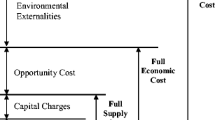This paper uses a dynamic model to explore the issue of irrigation-induced salinity, which puts irrigation at risk in most irrigated areas throughout the world. We address the design of instruments that an irrigation district board could implement to induce irrigators to take sustainable irrigation decisions. In our approach, the irrigators located above an aquifer participate in the accumulation of groundwater, a stock pollution. We analyse input-based instruments to induce the agents to follow the optimal stock path.
Similar content being viewed by others
References
D.L. Umali, Irrigation-Induced Salinity: A Growing Problem for Development and the Environment (World Bank Technical Paper 215, Washington, DC, 1993).
D.I. Smith, Water in Australia – Resources and Management (Melbourne, Oxford University Press, 1998).
R.M. Saleth, Towards a new water institution: economics, law, and policy, Econ. Polit. Wkly 29(39) (1994) A147–A155.
G.R. Marshall, Farmers cooperating in the commons? A study of collective action in salinity management, Ecol. Econ. 51 (2004) 271–286.
D. Wichelns, An economic model of waterlogging and salinization in arid regions, Ecol. Econ. 30(3) (1999) 475–491.
Z. Yang, Time preference, Stock externalities and strategic reactions – policy implications in climate change, Environ. Resour. Econ. 18 (2001) 233–250.
I.D. Ko, H.E. Kaplan and T. Sandler, Controlling stock externalities – Flexible versus inflexible Pigovian corrections, Eur. Econ. Rev. 36 (1992) 1263–1276.
W.D. Nordhaus and Z. Yang, A regional dynamic general-equilibrium model of alternative climate-change strategies, Am. Econ. Rev. 86(4) (1996) 741–765.
K.G. Mäler and A. de Zeeuw, The acid rain differential game, Environ. Resour. Econ. 12 (1998) 167–184.
L. Karp and J. Livernois, On efficiency-inducing taxation for a nonrenewable resource monopolist, J. Public Econ. 49 (1992) 219–239.
H. Benchekroun and N. van Long, Efficiency inducing taxation for polluting oligopolists, J. Public Econ. 70 (1998) 325–342.
O. Israelsen and V. Hansen, Irrigation Principles and Practices, 3rd ed., (p. 220, John Wiley, New York, 1967).
R.G. Cummings and J.W. Mc Farland, Groundwater management and salinity control, Water Resour. Res. 10 (1974) 909–915.
A.K. Saysel and Y. Barlas, A dynamic model of salinization on irrigation lands, Ecol. Model. 139 (2001) 177–199.
A. Dinar and A. Xepapadeas, Regulating water quantity and quality in irrigated agriculture: Learning by investing under asymmetric information, Environ. Model. Assess. 7 (2002) 17–27.
K.K. Datta, V.P. Sharma and D.P. Sharma, Estimation of a production function for wheat under saline conditions, Agric. Water Manag. 36(1) (1998) 85–94.
T.C. Bergstrom, J.G. Cross and R.C. Porter, Efficiency inducing taxation for a monopolistically supplied depletable resource, J. Public Econ. 15 (1981) 23–32.
S. Legras and R. Lifran, Systemic externalities at the catchment scale – consequences on the design of water rights market, 2004 World Water Week, 15–20 august, Stockholm, 2004.
Author information
Authors and Affiliations
Corresponding author
Rights and permissions
About this article
Cite this article
Legras, S., Lifran, R. Dynamic taxation schemes to manage irrigation-induced salinity. Environ Model Assess 11, 157–167 (2006). https://doi.org/10.1007/s10666-005-9031-5
Published:
Issue Date:
DOI: https://doi.org/10.1007/s10666-005-9031-5




